It's all about the classical music composers and their works from the last 400 years and much more about music. Hier erfahren Sie alles über die klassischen Komponisten und ihre Meisterwerke der letzten vierhundert Jahre und vieles mehr über Klassische Musik.
Total Pageviews
Thursday, May 8, 2025
YOUR LOVE - Ennio Morricone, from "Once Upon A Time In the West"
Friday, May 2, 2025
5 May 1891: Opening Night at Carnegie Hall
by Georg Predota
New York audiences and music lovers were treated to a momentous occasion in May 1891. Specifically, they witnessed the inaugural concert at Carnegie Hall, a concert venue in Midtown Manhattan in New York City, on 5 May 1891. Carnegie Hall would soon rise to become one of the most prestigious venues in the world of music.
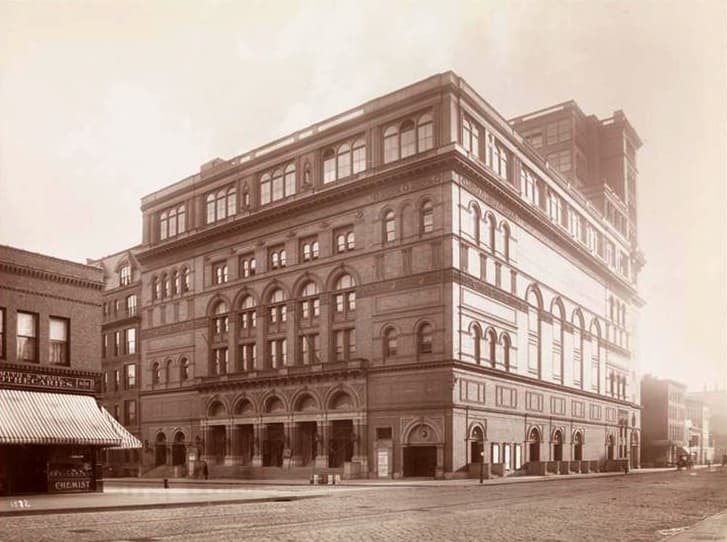
Carnegie Hall in 1895
The vision of a dedicated Music Hall was the brainchild of Leopold Damrosch, conductor of the Oratorio Society of New York and the New York Symphony Society. His son Walter, who met the businessman Andrew Carnegie during his studies in Germany, carried Leopold’s vision forward. Eventually, he was able to convince Carnegie to donate 2 million dollars and the Oratorio Society and New York Symphony bought nine lots at the southeast corner of Seventh Avenue and 57th Street.
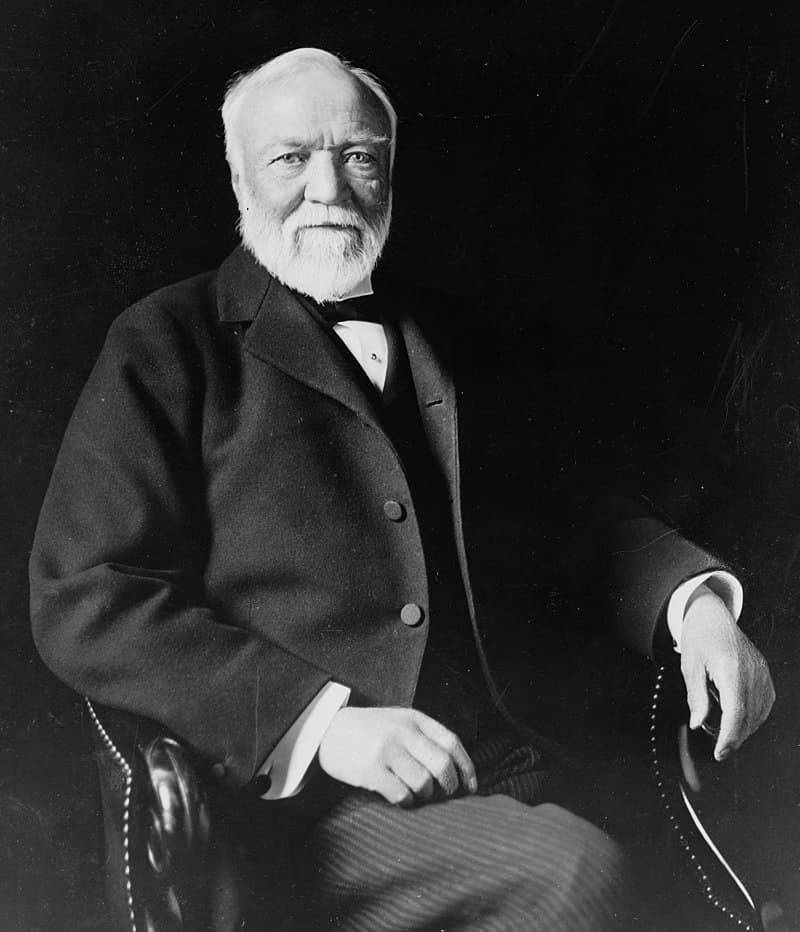
Andrew Carnegie
They approached architect William Burnet Tuthill, a talented amateur cellist and board member of the Oratorio Society to design the Music Hall. Tuthill had engaged in extensive studies of European concert halls, and he brought his experience with acoustics to bear on the Carnegie Hall project.
“Old Hundred” arr. Vaughan Williams
Designed in a modified Italian Renaissance style, the cornerstone for the Music Hall was laid by Carnegie’s wife Louise on 13 May 1890. Within the next 12 months, the original five-story brick and limestone building “containing a 3,000-seat main hall and several smaller rooms for rehearsals, lectures, concerts, and art exhibitions,” began to take shape. Andrew Carnegie said, “It is built to stand for ages, and during these ages, it is probable that this Hall will intertwine itself with the history of our country.” The Recital Hall opened in March 1891, and the Oratorio Hall in the basement opened on 1 April 1891. The Music Hall officially opened on 5 May 1891, starting a five-day Opening Week Festival.
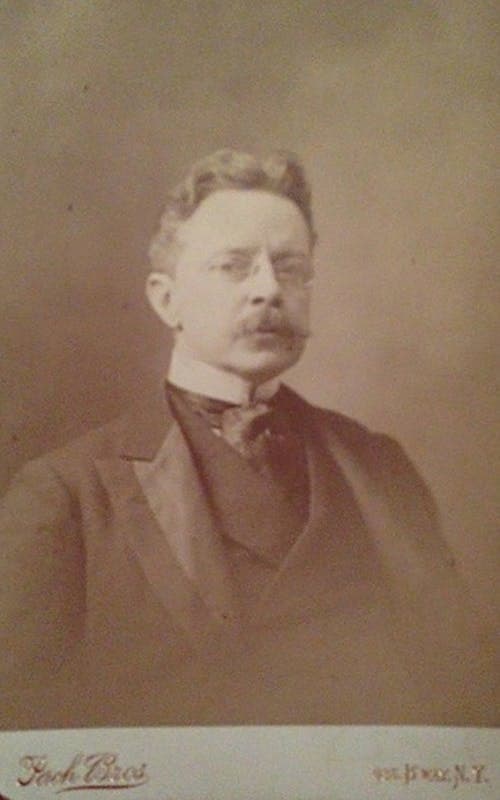
William Burnet Tuthill
Contemporary reports write of “horse-drawn carriages lining up for a quarter-mile outside, while inside the Main Hall was jammed to capacity.” Conductor Walter Damrosch led the New York Symphony Orchestra and the Oratorio Society on Opening Night, and Pyotr Ilyich Tchaikovsky had been engaged for a guest appearance. He was apparently paid $5,000 for his service, which in today’s money equates to roughly $150K.
A contemporary eyewitness reports, “People are swarming everywhere trying to get into this magnificent hall. The architecture is absolutely gorgeous with a façade made of terra cotta and iron-spotted brick. I manage to get inside where the main hall is jammed to capacity. I look around to see that the magnificent architecture extends to the inside as well. I looked up at the boxes to see the Rockefellers, Whitneys, Sloans, and Fricks families. I find my seat, smooth my dress, and sit down.”
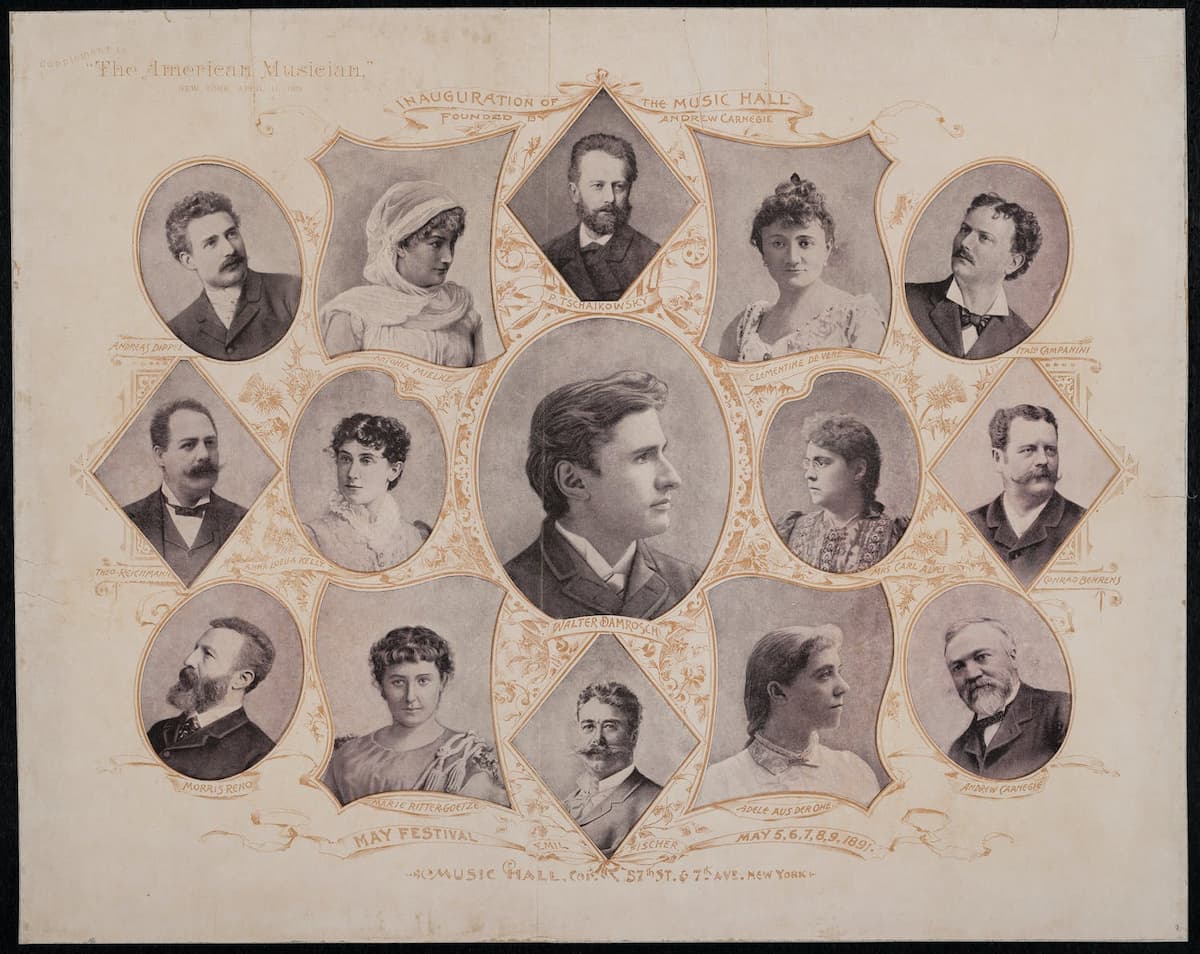
Carnegie Hall Opening Festival poster
The program opened with the hymn “Old Hundred,” a tune from the second edition of the Genevan Psalter. It is considered one of the best-known melodies in the Western Christian musical tradition, and it was the first work transmitted by telephone during Graham Bell’s first demo at the American Academy of Arts and Sciences in 1876. Bishop Henry Codman Potter delivered a lengthy speech praising Carnegie’s philanthropy. Walter Damrosch entered the stage and the hall erupted in applause. The New York Symphony played “America,” and Beethoven’s Leonore Overture No. 3. A member of the audience reported, “The acoustics are even better than I could imagine.”
Pyotr Ilyich Tchaikovsky: Marche solennelle
Then it was Tchaikovsky’s turn. In his diary, he writes, “In a crowded carriage I reached the Music Hall. Illuminate and packed with the public, it made an exceptionally striking and grandiose impression…The pastor gave a long and, it was said, exceptionally tedious speech, and after this, there was a very good performance of the Leonore Overture. Interval. I went downstairs. Excitement. My turn came. I was received very noisily. The march (Marche solennelle) went off beautifully. A great success! I listened to the rest of the concert from Hyde’s box. Berlioz’s “Te Deum” was rather tedious; it was only at the end that I really began to enjoy it.”
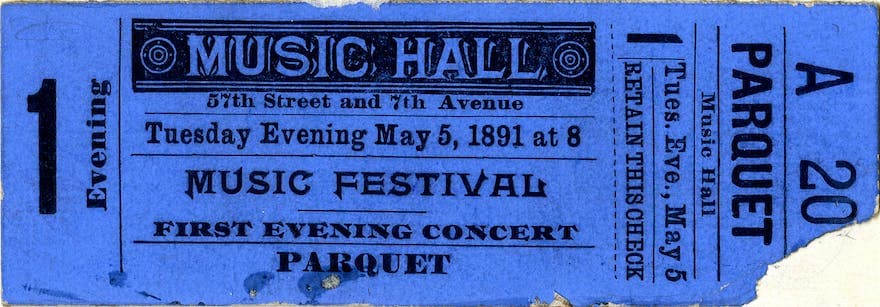
Ticket from the Opening Night at Carnegie Hall
Tchaikovsky was also less than enthusiastic about the review he read in the papers the next day. As he records in his diary, “Tchaikovsky is a tall, gray well built interesting man, well on the sixty?!!! He seems a trifle embarrassed and responds to the applause with a succession of brusque and jerky bows. But as soon as he grips the baton his self-confidence returns.”
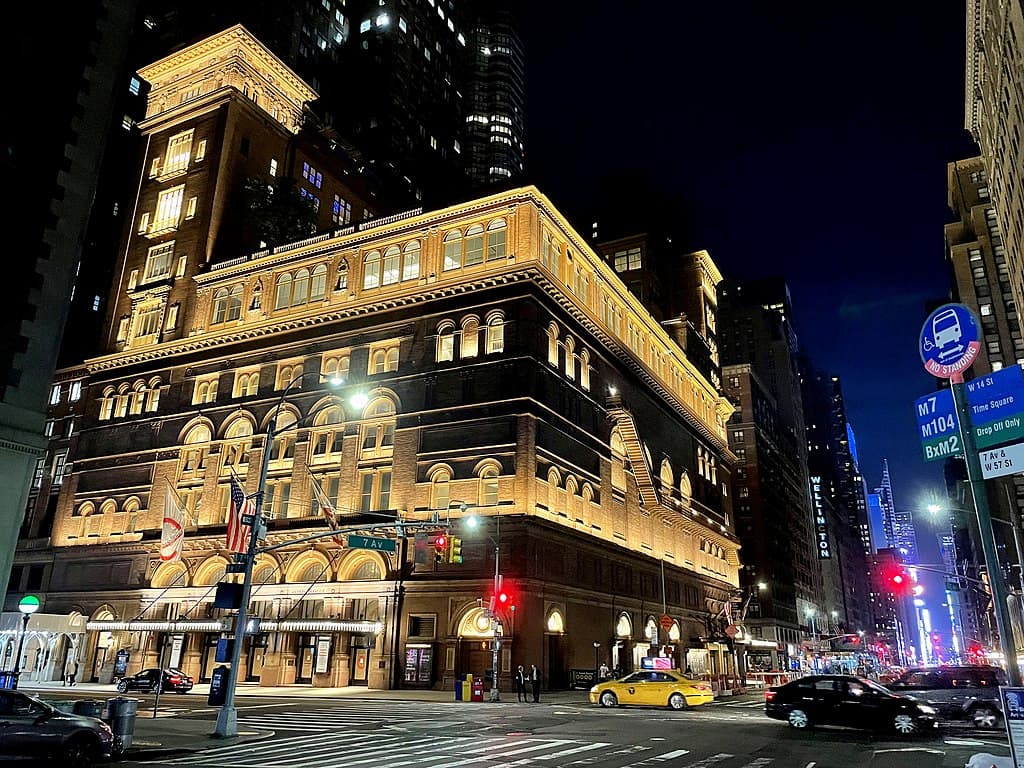
Carnegie Hall at night
Tchaikovsky was rather annoyed and added, “It makes me angry that they not only write about music, but about me personally. I cannot bear it when they comment on my embarrassment, and marvel at my brusque and jerky bows.” Tchaikovsky did not have much time to ponder the review, as he was in the audience at the second concert, which featured Mendelssohn’s oratorio “Elijah.”
Fugues and Other Musical Charms From Bach to Shostakovich
by Georg Predota
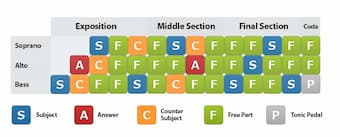
An example of a fugue structure © composerfocus.com
Among the most feared course requirements for many aspiring composers and students of music is a class simply labeled “Fugue.” And it’s no wonder, as a good many universities that still teach this kind of skills will ask you to sit in this particular class for an entire semester. And invariably, you will have to compose a fugue for your final project. The basic premise is simple enough. Take a short melody or phrase introduced in one part. That melody then taken up by other parts and developed by interweaving the parts. What sounds simple is in reality a highly complex process of rules and restrictions that is commonly regarded as the most fully developed procedure of imitative counterpoint.

Bach’s unfinished fugue in The Art of Fugue
It is hardly surprising that a good many composers past and present consider the process of writing a fugue an “exercises in a dead language.” Yet for the musical and expressive genius Johann Sebastian Bach (1685-1750), the possibilities within these restrictions were endless. His most celebrated and extensively studied collection of contrapuntal movements The Art of Fugue explores the possibilities inherent in a single musical theme. Demonstrating every compositional technique and method known to him, Bach composed eigthteen movements; fourteen fugues and four canons. The collection remained unfinished, however, as Bach died while incorporating his musical signature. How many more gripping jewels he might have composed, we will never know.
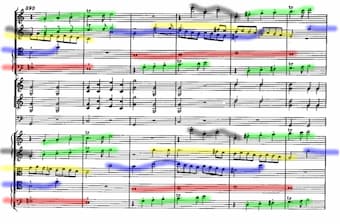
Mozart’s “Jupiter” fugal entries
Even during Bach’s lifetime, fugues and other forms of imitative counterpoint were considered seriously old fashioned. The aesthetics of music and culture had simply changed dramatically. During his extensive travels, Wolfgang Amadeus Mozart (1756-1791) was exposed to a multiplicity of compositional styles, tastes and genres. Mozart, the undisputed pop star of the 18th century, unrelentingly integrated, synthesized and transformed stylistic and musical conventions. It might reasonably be argued, however, that it took the encounter with the music of Bach and all those marvelous fugues that eventually produced compositions of universal appeal and stunning individuality. Mozart had been exposed to counterpoint throughout his life, but he engaged in serious study of fugue only during the 1780s. The diplomat Baron Gottfried van Swieten—who penned the libretto for Haydn’s Creation—was an avid collector of musical manuscripts. Wanting to have these works performed, he held regular musical parties in his Viennese residence, and Mozart was a steady guest. He reports to his sister, “nothing is played but fugues by Handel and Bach.” Mozart’s contact with the mastery of the German contrapuntal tradition opened a completely new musical horizon. He produced a number of stand-alone fugues, and this newly gained compositional skill helped to inform the creation of his final sublime orchestral masterpieces. Words simply can’t describe the jaw-dropping and breathtaking fugal display of quintuple invertible counterpoint in the final movement of the “Jupiter.”
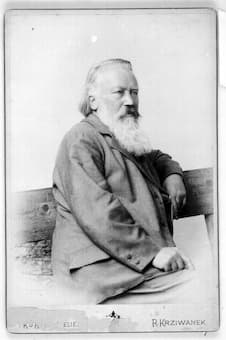
Johannes Brahms
In 1899, Ernest Walker addressed the 25th session of the Royal Musical Association with a lecture on Johannes Brahms. He described the composer’s musical style as a “fusion of heterogeneous materials with the desire for emotional expression.” Essentially then, Walker saw Brahms as the logical union of Bach’s contrapuntal art and Beethoven’s formal perfection. To his contemporaries and critics, Brahms looked like a bastion of musical conservatism. Surprisingly, it was Arnold Schoenberg who suggested that Brahms was “a great innovator in the realm of musical language, and that his chamber music prepared the way for the radical changes in musical conception at the turn of the 20th century.” But let’s be clear, musical language for Brahms always starts in strict accordance with his extensive knowledge of counterpoint and fugue. He studied every available treatise on this subject and the integrity of the musical structure is paired with the attempt to achieve a deeper level of contrapuntally inspired motivic cohesion. Just listen to the finale of his E-minor Cello Sonata, a movement that epitomizes Brahms’ style. The fugal subject is derived from Bach’s Art of Fugue, and the movement weaves together a highly contrapuntal style with the exploitation of the possibilities inherent in sonata form. Through his study of fugue, Brahms became aware of his place within the Classical tradition, and the inspiration he drew from it resulted in the revitalization of classical form.
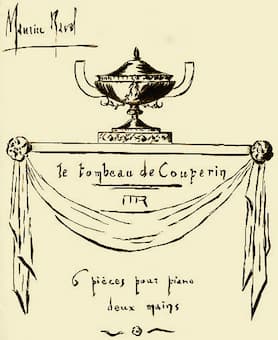
Ravel: Le Tombeau de Couperin
As a young student, Nadia Boulanger discovered Maurice Ravel cheerfully writing counterpoint exercises in Fauré’s class. She recalled, “I had a surprise when I found myself in Fauré’s class and discovered Ravel was there, too, doing as I used to do then, traditional counterpoint. I didn’t always find it interesting, yet it seemed quite natural that Ravel should do it… It was only years later that I asked him why he was still studying counterpoint. ‘One must clean the house from time to time; I often do it that way,’ he replied.” Ravel’s devotion to the discipline of counterpoint and fugue provided the basis for his elegant and imaginative contrapuntal virtuosity. In fact, Ravel’s first-level entries in the Prix de Rome competitions between the years 1900 and 1905 were naturally five fugues. His engagement with strict contrapuntal forms continued in the piano suite Le Tombeau de Couperin, completed when he was discharged from military service in 1917. First performed by Marguerite Long in 1919, the audience was suitably surprised and impressed to discover that a meandering and jazz-inspired “Fugue” was part of the collection.
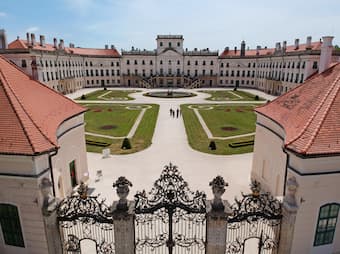
The Esterházy castle
Joseph Haydn (1732-1809) entered into the services of the Esterházy family as a court musician in 1761, and he would remain on the job for a total of 41 years. Much of his career was spent at the family’s remote estate, with Haydn reporting “Well, here I sit in my wilderness; forsaken, like some poor orphan, almost without human society… nobody is nearby who could distract me or confuse me about myself. I had no choice but had to become original.” Haydn had turned forty and was working on his six string quartets opus 20, when originality struck. Whereas in earlier efforts he would often fuse the viola and cello parts together in one musical line, he now made the fullest use of four completely independent voices. And one of the clearest ways of demonstrating complete independence of individual voices is to write strict counterpoint and fugues.
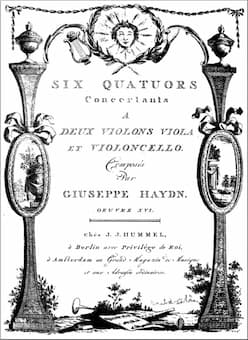
Haydn: Sun Quartets, Op. 20
For his opus 20, subsequently nicknamed “Sun Quartets” because the sun is displayed on the cover of the first edition, Haydn composed three fugal finales. Haydn was undoubtedly the leader of fugal composition and technique in the Classical era, and writing fugal finales also offered a brand new solution to the relative weighting of all movements. These fugues are not dry academic exercises, however, as Haydn greatly expanded the texture and dynamics and experimented with flexible phrase length and structure. Every measure is full of variety and unpredictability, with Haydn combining his extensive knowledge of historical sources with the furthest reaches of his brilliant musical imagination.
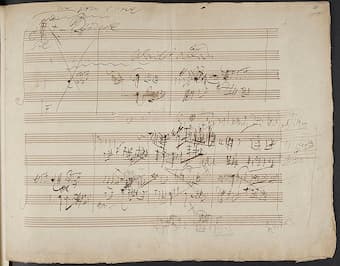
Beethoven: Sketches for the String Quartet Op. 131
As a young and eager student of music, Ludwig van Beethoven (1770-1827) received thorough instruction in counterpoint and fugal writing. During his early days in Vienna he even attracted attention by playing fugues from the Well-Tempered Clavier on his recitals. Fugal passages are found in his early piano sonatas and also in the “Eroica,” but fugues did not take on a central role in Beethoven’s oeuvre until late in his career. No doubt you are familiar with the fugue in the Cello Sonata, Op. 102 No. 2, the technically devilish fugue in the “Hammerklavier,” the massive dissonant fugue published as “Große Fuge” Op. 133, and fugal passages in the Missa Solemnis and the Ninth Symphony. However, it is his Opus 131 string quartet that is considered the pinnacle of his creative output. Writing in 1870, Richard Wagner published a poetic description of the work, “Tis the dance of the whole world itself: wild joy, the wail of pain, love’s transport, utmost bliss, grief, frenzy, riot, suffering, the lightning flickers, thunders growl: and above it the stupendous fiddler who bears and bounds it all, who leads it haughtily from whirlwind into whirlwind, to the brink of the abyss – he smiles at himself, for to him this sorcery was the merest play—and night beckons him. His day is done.” Written during a period of immense personal suffering, the opening fugue has been called “the most superhuman piece of music that Beethoven has ever written.” It is like a mysterious vision of another universe and represents for some critics “the melancholiest sentiment ever expressed in music.”

Simon Sechter
A few months before his death, Franz Schubert (1797-1828) first laid eyes on a score of Handel oratorios. “Now for the first time,” he writes, “I see what I lack, but I will study hard with Sechter so that I can make good the omission.” Simon Sechter was probably Vienna’s most famous teacher of counterpoint, and he recalled, “A short time before Schubert’s last illness he came to me… in order to study counterpoint and fugue, because, as he put it, he realized that he needed coaching in these.”
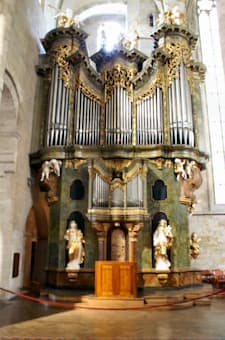
Organ at Heiligenkreuz Monastary
Schubert only managed to have one lesson with Sechter, before he was taken severely ill. He wrote to a friend eight days later, “I am ill. I have had nothing to eat or drink for eleven days now, and can only wander feebly and uncertainly between armchair and bed.” One week later Schubert passed away. Around his lesson with Sechter and his untimely death, Schubert and his friend, the composer Franz Lachner, visited the Heiligenkreuz monastery south of Vienna. Apparently, it was Schubert who suggested that they each write a fugue for the famous organ, which they both did. The Schubert manuscript is lost, but a copy of the work, written in four staves instead of the normally three for organ, did survive. As such, it was first published in 1844 for organ or piano four-hand, but it might well be the case that this fugue represents the very last composition Schubert ever completed.
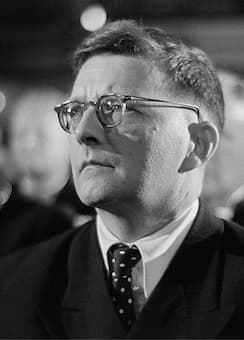
Dmitri Shostakovich © Deutsche Fotothek
Dmitri Shostakovich (1906-1975) rapidly composed his Twenty-Four Preludes and Fugues between 10 October 1950 and 25 February 1951. This polyphonic cycle is the first work composed in the twentieth century that follows the tradition and the dimension of Bach’s Well-Tempered Clavier. The Shostakovich cycle embraces all twenty-four keys, however, it is organized around the circle of fifths, and not in chromatic ascending order like Bach. We know that Shostakovich played the Bach preludes and fugues as a young boy, and in 1950 he was an honorary member of the jury of a piano competition organized in Leipzig for the 200th anniversary of the death of Bach. Bach’s music, and especially the Well-Tempered Clavier, must have given Shostakovich a certain creative impulse and in conversation with some German musicians in Leipzig he exclaimed, “Why shouldn‘t we try to continue this wonderful tradition.” Back home, Shostakovich was in political hot water, fired from his teaching positions in Moscow and Leningrad, with his music officially banned from concerts and broadcast. In fact, he was on the verge of suicide, and he “decided to start working again… I am going to write a prelude and fugue every day. I shall take into consideration the experience of Johann Sebastian Bach.” As with Mozart, Beethoven, and Schubert, the fugue served as the vehicle for the expression of the most personal, intimate and uncompromising thoughts and feelings.
Maurice Ravel as a Young Man
by Siri Livingston
Maurice Ravel was born on the 7th of March 1875, at Ciboure, a little fishing village at the base of the Pyrénées near the French-Spanish border. Members of Ravel’s family on the paternal side had emigrated to Switzerland, and Stravinsky’s sharp but witty barb – that Ravel was “the most perfect of Swiss watchmakers” in music and personality – led to a rather inaccurate association of Ravel with the Swiss by the general public. Indeed, Ravel had greater claims to Spanish roots than Swiss, his mother having spent her youth in Madrid, and his parents having met and fallen in love in Aranjuez, the romantic city known for its summer palace and gardens, as well as the concerto for guitar and orchestra, Concierto de Aranjuez.
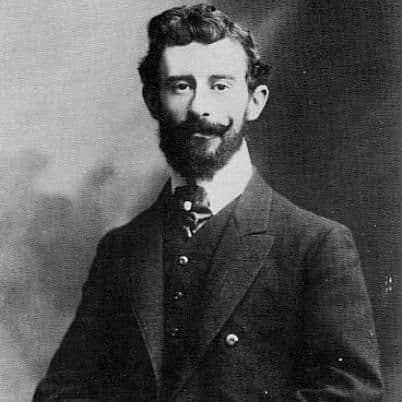
Maurice Ravel
Shortly after Maurice was born, the family relocated to 40 rue des Martyrs, Montmartre, Paris. Soon, the happy couple had a second son, Edouard, of whom Ravel was deeply fond for his entire life. For, indeed, it was a happy little family – Ravel was exceptionally close to his mother, and Ravel’s father, a skilled engineer, was only too happy to encourage Ravel in his artistic pursuits. Edouard followed in his father’s footsteps and became an engineer, but on both sides of the family – the engineers and the artists – there seemed to be mutual interest and respect. Ravel noted in later years that his father had given him a strong amateur grounding in music and artistic taste, and in his music-related travels, Ravel was always sure to send news to his father and brother of any interesting technology he encountered.
In 1889, Ravel passed the entry exam to study piano at the Paris Conservatoire, and in the class of Eugène Anthiome met a key player in the story of his life and work. Ricardo Viñes, a young pianist who would one day become a leading interpreter of the music of Isaac Albéniz and Manuel de Falla, became fast friends with the young Maurice, and a tradition was born: their mothers would chatter away in Spanish while the young boys played piano duets. It was to Viñes that Ravel’s Menuet antique was dedicated, and Viñes premiered it at the Salle Érard in 1898.
Maurice Ravel: Menuet antique
On the whole, however, Ravel’s experience of the Conservatoire was not an entirely smooth one. He remained at the Conservatoire for fourteen years, an unusually long time. He was not one to seek academic distinction for its own sake, and his resistance to conventional ideas and the imposition of others upon his style created various difficulties in entering and competing in the illustrious Prix de Rome on numerous occasions.
While he did win prizes for piano and advanced to better classes in both piano and harmony, Ravel began to feel he had learnt what he could from the Conservatoire, and was expelled for this attitude in 1895 – the first of several expulsions for failure to adhere closely to the Conservatoire’s rigid rules. It was in studying with composer Gabriel Fauré that Ravel found a way of being at the Conservatoire that truly suited him, and the composer became a treasured friend and mentor when Ravel renewed his studies in 1898.

Maurice Ravel with Ricardo Viñes, 1901
In addition to Fauré, at a young age, Ravel had already identified three musical figures who were his greatest compositional inspirations: Emmanuel Chabrier, Erik Satie, and Mozart. In a lecture given in 1928, Ravel said of Satie:
“Satie possessed an extremely alert intelligence, keyed to inventiveness… [he] pointed the way with simplicity and ingenuity; but as soon as another musician followed his lead, Satie immediately changed his own direction and then, without hesitation, opened a fresh way to new fields or experiment… we have today… many a work which would not have existed had Satie not lived.”
Ravel’s next work to be premiered for the public was his Shéhérazade, an overture to a projected but abandoned opera, and his first work for orchestra. The work was not well received, and Ravel himself dismissed it as “clumsy hotch-potch.” His next serious commission has become one of Ravel’s best-known and beloved works: the Pavane pour une infante défunte. For solo piano and dedicated to his patron, the Princesse de Polignac, the piece is not, as many incorrectly assume, a pavan for a deceased child. Rather, the “enfant” here refers to “infanta,” or princess, and the “défunte” refers less to literal death than to a bygone age or the distant past. As such, the work is a kind of otherworldly, surreal imagining of the dance of a princess of a lost age, and Ravel often wittily chided pianists who played it too slowly by saying it was the princess, not the pavane itself, that was dead. The work is incredibly harmonically rich and showcases Ravel’s profound understanding of the timbral qualities of chord spacings at the piano. Its charm, carefully constructed inner voicings, and delicate interplay of line have made it an enjoyable and accessible challenge for generations of pianists.
In the pavane we also see emergent preoccupations that were to be Ravel’s for the rest of his life – his enjoyment of old dance style and form, his fascination with the heritage of both Spain and France, and his deliberate assimilation of arcane soundworlds into his musical style. At the turn of the century, armed with a strong sense of his own musical interests and sensibility, Ravel was poised and ready to earn his lifelong stature as a great composer – but there were still some bumps in the road ahead…
Wednesday, April 30, 2025
Julie Huard - Die With A Smile (Live Version)
Nicole Scherzinger Disney Mulan "Reflection" Live Coronation Concert
Colors of the Wind - Live Orchestra | Pocahontas Masterpiece
Tuesday, April 29, 2025
13 year old performs Bohemian Rhapsody in front of 10,000+ students!
Michel Béroff at 75: a pianist beyond borders
James Jolly
With a milestone birthday on the horizon, James Jolly meets the pianist Michel Béroff to find out how this French musician forged a major reputation with a broad repertoire

Often when I’ve interviewed French pianists the subject has been their native music, and, invariably, after enthusing about their extraordinary rich musical heritage – Debussy, Ravel, Saint-Saëns, Satie, Fauré, Messiaen and many others – they’d pause and say something along the lines of: ‘But I wish concert promoters/A&R executives would ask me to play some Brahms or Beethoven’. It’s not something an Italian, British or American pianist would ever have to worry about, but for some reason French players have invariably been constrained – hardly le mot juste – to play their own music. It’s no hardship, of course, and it has given us some staggering performances and recordings. (Nowadays things have relaxed a bit – Alexandre Kantorow, for example, is one of the finest Brahms players of his generation and he sailed through the three rounds of the 2019 Tchaikovsky Competition offering just a single Fauré nocturne to fly the Tricolour.) One pianist, though, who side-stepped this pigeon-holing very early on – though he certainly hasn’t avoided French music – is Michel Béroff, who celebrates his 75th birthday on May 9. To mark the occasion Erato has gathered together all his recordings made for the label and the various branches of EMI and issued them in a 42-CD set. And nestling among them is his set of the five Prokofiev piano concertos that put him on the international music map (not to mention his cherishable Debussy recordings including Pour le piano, Estampes, Images, Préludes and much else.)
I took the train to Paris to talk to Béroff, a musician who introduced me to a large swathe of the piano repertoire in my teens, to look back over a distinguished career. We met up on a beautiful spring day and reminisced over a cup of coffee.
20th-century music was natural to me because when you are young, your mind is open, your hard drive empty
MICHEL BÉROFFThere are a number of his recordings I’ve owned for years that I wanted to ask him about, and the first was – yes, French music! – Olivier Messiaen’s Quatuor pour la fin du temps, a work he recorded at the Abbey Road studios in 1968 while still a teenager. ‘I first met Messiaen when I was 11 years old, so it would have been in 1961. It came about because my father took a few lessons with Messiaen during the war and we also had a friend who was one of his harmony students. So I started playing his music because my father loved it very much – my mother had bought him the score of Vingt regards sur l’enfant Jésus. Since I was learning the piano he gave me the music and I began to play some of the pieces – I was maybe nine years old. Then, at 11, I went to a meeting with Messiaen, and I played for him and [his wife, the pianist] Yvonne Loriod.’ I suggest that they must have pretty amazed at this little boy playing such music. Béroff laughs. ‘Of course! They’d never seen anyone so young playing these pieces. So that was how I began with his music. And then I won First Prize in the Messiaen Competition in 1967. I was only the second person after Loriod to play the complete Vingt regards. Of course being young there were so many things I should have asked Messiaen but at that age you don’t think like that. I used to see him a lot and knowing a composer is fantastic, and I should have been more curious. But Messiaen’s music has been like baby milk to me – I heard it even before I started playing. And for me it was always very natural. It’s been with me throughout my life.’

Michel Béroff recording in Leipzig with the Gewandhaus Orchestra and Kurt Masur
The HMV recording of the Quartet, the work that Messiaen wrote for clarinet, violin, cello and piano in 1940 while a prisoner of war in Stalag VIII-A, followed Béroff’s win in the Messiaen prize. For it the 18-year-old Béroff was partnered by some pretty illustrious UK-based players, all of whom were at least 25 years older than him: Gervase de Peyer (clarinet), Erich Gruenberg (violin) and William Pleeth (cello). ‘They were really wonderful musicians,’ Béroff recalls. ‘Before the sessions I went to see Messiaen for advice. He didn’t actually have much to say: it was just a question of adjusting some dynamics, and where the music was so slow that even a string or woodwind player could not do it without too much phrasing, he agreed that it should be a little bit faster than what he wrote. So it was just a few small things which I still have in my score. I was really very happy to do this because it was a great introduction to making recordings. The sleeve design was done by a woman called Arlette de Grouchy – she was in charge of the recording covers – and she had found this image which I found very flashy. But Messiaen, who experienced synaesthesia, approved because he couldn’t see any colours that he didn’t like!’
Béroff enlarged on his approach to the repertoire. ‘This 20th-century music was something natural to me, because when you are young, you are free, your mind is open. You have lots of places inside you – your hard drive is really empty. So it could be Webern or Boulez or Schoenberg – everything is simple to learn. There is no contradiction. You can learn sometime Bach or Mozart or Schoenberg. If you do this later, intellectually it’s much more difficult. So for me it was natural, but it was also out of the question not to play Mozart, Liszt, Chopin, Schumann, Beethoven – all the things which you learn and just couldn’t live without. Someone told me about some kind of biography of me they’d read – it was so ridiculous – it said I was playing only 20th-century music, except the Mozart sonatas! This was stupid because I played some Mozart but never made Mozart a big part of my repertoire. But of course Russian repertoire has been very important – I’ve played a lot of Stravinsky, Mussorgsky and, of course, Prokofiev. Maybe it was my background – my father was born in Bulgaria which is very close to Russia. But Bartók I love even more than Prokofiev, I must say. For me he is the greatest of the composers of the first part of the 20th century.’
Two other recordings I wanted to talk to Michel Béroff about were ones he made in 1974 in Leipzig with the Gewandhaus Orchestra and Kurt Masur – that career-changing set of the complete Prokofiev piano concertos and all of Liszt’s concertante works for piano. ‘I’m not sure why they were made in Leipzig,’ Béroff muses. ‘Probably it had to do with being cheaper. If they didn’t sell well it wouldn’t be too bad! It was always very strange having to go to Berlin and pass through Checkpoint Charlie. But the orchestra was very fine – the only thing that sometimes was a weakness with those East German ensembles were the woodwinds because they didn’t have access to good instruments. Kurt Masur in Leipzig was very strict, and worked everyone very hard. Interestingly, when he later came to the West – I worked with him in London, in New York and on tour – he became much more free, much nicer and much more generous. He was a different person, a very nice man.’ (Béroff also played with the Staatskapelle Dresden and Eugen Jochum. He recalls that it was his first Brahms Second Concerto and it was broadcast. He was asked for his permission, more as a courtesy, and was then rather surprised when in Japan some time later he saw that the performance had been issued on LP.)
The Prokofiev set was only the second of the five concertos to be made in the West (preceded by John Browning’s RCA survey with the Boston Symphony and Erich Leinsdorf, and subsequently reissued by Testament). To return to my opening comments about French repertoire and French pianists, Béroff attributes his atypical repertoire to his teacher, one of the major musical figures in France at the time, to Pierre Sancan, who also taught, inter alia, Jean-Philippe Collard, Emile Naoumoff, Jacques Rouvier, Jean-Bernard Pommier and Jean-Efflam Bavouzet (who credited Sancan as being ‘the Master who gave me all the means I needed … to truly become a pianist’).
Sancan’s method, and he is known for tailoring his approach to his individual students, drew on the Russian school of pianism. As Béroff explains it, it was not only focused on the fingers and sometimes the wrists à la française, but also involved the arms and shoulders – the resultant, and more muscular, approach clearly set Béroff up to tackle the Prokofiev concertos (something that Bavouzet would later also do, with comparable success). The Prokofiev set was a commercial hit, and Béroff would later often play all the concertos, Nos 3 and 5 the most, and when he had to take a break from performance with two hands due to focal dystonia, he would play No 4 (for the left hand) quite often. But when pressed he revealed a particular fondness for No 2 – ‘You know, like with Bartók, No 2 is my favourite. And this number is magic for composers … just think of Brahms No 2!’
The Prokofiev set led to the Liszt collection. ‘Obviously there were quite a few pieces which I’d never played – and never have since! – and I suspect there have been a few other things that have been found since then. But at the time it was the first complete recording of all the music for piano and orchestra. And there are some wonderful things there, like that early piece for strings, Malédiction, with some very avant-garde writing. It was very interesting for me to do this and I enjoyed it very much and obviously I got along very well with Masur.’
Mention of Kurt Masur led us on to some of Béroff’s other conductor collaborators: ‘I was really fascinated by Seiji Ozawa [with whom he recorded the Stravinsky concertante works]. Pierre Boulez – there’s was really nothing to say because he was so helpful. We started with Bartók’s Second with the New York Philharmonic in 1972. We often worked together and he was so nice. He had quite a reputation but it couldn’t have been more wrong. Of course, if someone was trying to trap him with questions, he could kill them in just one sentence. An Englishman I liked very much was Colin Davis. He was a very good musician, so humble and such a nice person to work with, really fantastic. I also enjoyed working with Andrew Davis, a very warm person. Bernstein, of course, because he was such an amazing man! And Michael Tilson Thomas was also great to work with, probably because he was also a really good pianist. And André Previn [with whom Béroff made one of the finest recordings ever of Messiaen’s Turangalîla-Symphonie] was such a gifted musician. And Claudio Abbado [with whom he recorded, for DG, the Ravel Left-hand Concerto] was such a wonderful conductor.’
These days Béroff conducts, teaches – Seong-Jin Cho was one of his students – and sits on numerous competition juries. The Chopin Competition beckons later this year, but meanwhile he’s still surprised, and flattered, to be the focus of this retrospective Erato set, quite a tribute to a musician who has contributed so much to the recorded catalogue.

